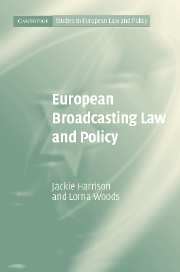Book contents
- Frontmatter
- Contents
- Series Editors' Preface
- Preface
- Case list
- PART I
- 1 Introduction
- 2 The value and functions of the broadcast media: protecting the citizen viewer
- 3 Regulation and the viewer in a changing broadcasting environment
- 4 Union competence
- 5 European broadcasting policy
- PART II
- PART III
- Appendix
- Bibliography
- Index
3 - Regulation and the viewer in a changing broadcasting environment
Published online by Cambridge University Press: 29 July 2009
- Frontmatter
- Contents
- Series Editors' Preface
- Preface
- Case list
- PART I
- 1 Introduction
- 2 The value and functions of the broadcast media: protecting the citizen viewer
- 3 Regulation and the viewer in a changing broadcasting environment
- 4 Union competence
- 5 European broadcasting policy
- PART II
- PART III
- Appendix
- Bibliography
- Index
Summary
Introduction
The dual nature of broadcasting as a cultural phenomenon and a commercial product causes difficulties for policymakers and regulators seeking to reconcile the conflicting interests that arise. The history of broadcasting and its regulation in the Union illustrates a variety of responses to these difficulties. There have been changes in the broadcasting sector, both in the increasingly commercial nature of the market structure and in technology. A central question is the extent to which these changes necessitate different regulatory approaches or, indeed, minimise the need to rely on traditional regulation to achieve policy goals. Two external factors, technological change and commercialisation (identified in chapter 1), are interlinked with different perceptions held by policymakers, regulators and, probably, broadcasters as to what the viewing experience should constitute, and consequently the viewer's needs, in an international information society. The interrelationship of technological change, commercialisation and these perceptions raises questions about the appropriate level and type of regulation needed. In this context, there is a tension between the needs of the consumer and the citizen, as well as in their different dispositions towards new technology.
To identify the extent to which regulatory responses are first, technologically determined, and secondly, influenced by industry claims, we will consider briefly the historical development of broadcasting and previous regulatory responses to earlier technological innovations. Following on from the analysis in chapter 2, we discuss these responses in the light of the historical social and moral concerns about broadcasting.
- Type
- Chapter
- Information
- European Broadcasting Law and Policy , pp. 41 - 61Publisher: Cambridge University PressPrint publication year: 2007



